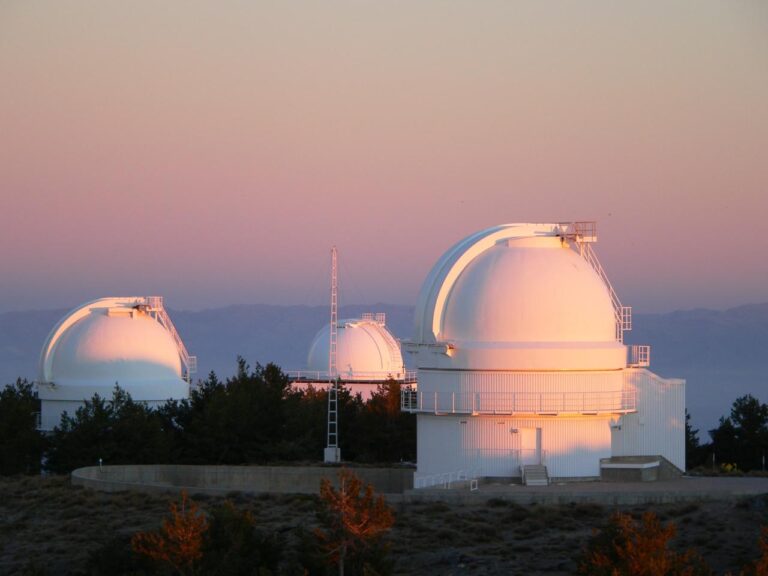Perched high in the Sierra Nevada mountains of Andalusia, Spain, the Calar Alto Observatory stands as a beacon for astronomical research. This collaborative European project, a joint venture primarily between Spain and Germany, offers a privileged window into the cosmos, enabling scientists to probe the depths of the universe from one of Europe’s premier astronomical sites.
Far from the light pollution of urban centers, the observatory’s strategic location at over 2,100 meters above sea level provides exceptionally dark and clear skies, crucial for capturing the faint light from distant celestial objects. The dry climate and minimal atmospheric turbulence further enhance the observing conditions, making Calar Alto an ideal platform for a wide range of astronomical investigations.
At the heart of the observatory lie several state-of-the-art telescopes, each designed to tackle specific astronomical questions. Among the most prominent are:
- The 3.5-meter telescope: Equipped with advanced instruments, this versatile telescope is used for a broad spectrum of research, from studying exoplanets and stellar evolution to investigating distant galaxies and quasars.
- The 2.2-meter telescope: This workhorse of the observatory has contributed significantly to various fields of astronomy, including studies of star formation, galactic dynamics, and cosmology.
- The Schmidt telescope: While historically significant for its wide-field surveys of the sky, this telescope continues to play a role in specific research projects.
- The 1.23-meter telescope: Another valuable instrument for diverse astronomical observations, often used for long-term monitoring projects.
These telescopes, equipped with sophisticated cameras, spectrographs, and other specialized instruments, allow astronomers to collect and analyze the light from celestial objects across the electromagnetic spectrum. By meticulously studying this light, scientists can decipher the physical properties of stars, galaxies, nebulae, and other cosmic entities, unraveling the processes that govern their formation, evolution, and interactions.
Unveiling Cosmic Mysteries: Research at Calar Alto
The research conducted at Calar Alto spans a vast array of astrophysical topics. Scientists utilize the observatory’s capabilities to:
- Search for and characterize exoplanets: Investigating planets orbiting stars beyond our solar system, including the search for potentially habitable worlds.
- Study star formation and evolution: Observing the birth, life, and death of stars, gaining insights into the fundamental processes that shape our galaxy.
- Explore the dynamics of galaxies: Investigating the structure, motion, and interactions of galaxies, including our own Milky Way and distant galactic systems.
- Probe the distant universe: Studying quasars, active galactic nuclei, and the large-scale structure of the cosmos to understand the evolution of the universe itself.
- Investigate transient phenomena: Observing supernovae, gamma-ray bursts, and other short-lived cosmic events to understand the extreme physics involved.
The data collected at Calar Alto contributes significantly to the global effort to understand our place in the universe. The findings published by researchers using the observatory’s facilities have advanced our knowledge in numerous areas of astrophysics, shaping our understanding of the cosmos.
Visiting the Realm of Telescopes: Experiencing Calar Alto
For those with an interest in astronomy, the Calar Alto Observatory offers a unique opportunity to connect with the wonders of the universe. While access to the telescopes themselves is generally restricted to researchers, the observatory often hosts guided tours and open days, allowing the public to learn about the science conducted there and appreciate the impressive infrastructure. Visitors can marvel at the size and complexity of the telescopes, learn about the history of the observatory, and gain a deeper understanding of the astronomical research being carried out.
Standing under the pristine night skies surrounding Calar Alto, far from the glare of artificial light, offers a profound appreciation for the vastness and beauty of the cosmos. While you might not be peering through a giant telescope yourself, the experience of being at a world-class astronomical observatory, knowing that groundbreaking discoveries are being made just a short distance away, is truly inspiring.
The Calar Alto Observatory stands as a testament to human curiosity and our relentless pursuit of knowledge about the universe. Its strategic location, advanced telescopes, and the dedicated work of international scientists continue to contribute significantly to our understanding of the cosmos, making it a vital landmark in the landscape of astronomical research.



